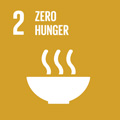- Docente: Cristina Angeloni
- Credits: 6
- SSD: BIO/10
- Language: Italian
- Moduli: Cristina Angeloni (Modulo 1) Silvana Hrelia (Modulo 2)
- Teaching Mode: In-person learning (entirely or partially) (Modulo 1); In-person learning (entirely or partially) (Modulo 2)
- Campus: Rimini
- Corso: Second cycle degree programme (LM) in Human Nutrition, Well-Being And Health (cod. 6775)
-
from Oct 03, 2025 to Dec 09, 2025
-
from Nov 18, 2025 to Nov 25, 2025
Learning outcomes
At the end of the course the student: -knows the basic elements on the biochemical and nutritional role of macro and micronutrients contained in foods commonly used in human nutrition. - will be able to understand the rational use of the main food supplements and phytocomplexes and is able to communicate the guidelines for proper nutrition, in the context of consolidated healthy lifestyles also collaborating in nutritional education programs.
Course contents
MODULE 1
Defining Food Science and Nutrition Science. Food quality and its determinants from farm to fork. The role of consumers and the new "from fork to farm" assumption.
Formulation of dietary guidelines: BMI and biochemical evaluations, RDA, food pyramids. The Mediterranean diet as an example of sustainable diet. Nutrient classes. The seven classes of foods.
Carbohydrates: food sources, digestion, absorption, metabolism and function. Lactose intolerance. Galactosemia. Foods and glucose tolerance, glycemic index, nutrition of the diabetic. Non energy related functions of carbohydrates. Dietary fiber. Cereals and pseudocereals.
Fats: food sources, absorption, metabolism and function. Saturated, monounsaturated and polyunsaturated fatty acids. Trans fatty acids. N-6 and n-3 fatty acids: biosynthesis, metabolic functions, RDA, nutritional sources. Cholesterol nutrition and the control of serum cholesterol concentration. Lipoproteins. Oxidative stress: reactive oxygen and nitrogen species. Intracellular and extracellular antioxidants. Functional foods and nutraceutical compounds in the prevention of chronic degenerative diseases.
Proteins: essential aminoacids, food sources of proteins and protein quality, digestion, absorption, metabolism and function. Nitrogen balance. Protein requirements. Protein and disease: homocystinuria, phenylketonuria, celiac disease, protein malnutrition.
Nutrition and metabolism of vitamins: nomenclature, sources and properties. Vitamin A, D, K and E: absorption, metabolism, storage, functions, requirements, deficiency and toxicity. Vitamin C: function, metabolism, requirements, deficiency and toxicity. The B vitamins involved in the intermediary metabolism: function, metabolism, requirements, deficiency and toxicity. Interaction of drugs with vitamins.
Nutrition and metabolism of the major minerals and of trace elements: absorption, metabolism, excretion, storage, requirements, deficiency and toxicity
Dietary supplements: definition and legal regulation in the EU dimension. Reasons for taking supplements. Vitamin supplements and mineral supplements: judging the adequacy of micronutrient intakes. Protein supplements. Branched chain aminoacids and creatine: rationale and evidence for the use of supplements. Dietary supplements in sedentary people and in physical activity.
MODULE 2
Water: endogenous and exogenous sources. Water requirement. Water homeostasis in the body.
Alcoholic beverages. Absorption, distribution and metabolism of ethanol. Effect of ethanol on nutritional status, CNS, cardiovascular system, body temperature. Amount of alcohol allowed in the diet.
Caffeine-containing foods: coffee, tea, cocoa and chocolate. Effects of caffeine
Readings/Bibliography
Scienza dell’alimentazione • Prima edizione - Anna Maria Giudetti, Raffaele Cagnazzo, Francesco Cagnazzo - Casa editrice edi·ermes. ISBN: 978887051827-6
A. Di Giulio, A. Lorenzini, M. Malaguti - Principi di Nutrizione, Casa Editrice Ambrosiana, 2024 (volume 1 della collana: Alimentazione per lo sport e il benessere).
Biochimica della Nutrizione. CARLA PIGNATTI. Società Editrice Esculapio, Bologna, 2022
Advanced Nutrition and Human Metabolism (Sareen S. Gropper, Jack L. Smith etc.). Ed. Cengage Learning; 8° edition ISBN-10: 0357449819
Teaching methods
Lectures with the help of presentations in Power Point format.
Didactic materials (presentations with written text) prepared ad hoc by the teacher and usable in pdf format, provided before and during the lesson, will be made available in the Virtual environment, as well as articles from scientific journals published in open access and videos of the lessons recorded with the Panopto system (video-lesson) provided at the end of the lesson and available throughout the Academic Year in a Virtual environment.
In particular, the use of the lessons in asynchronous mode will allow students to prepare themselves for the exam, possibly with the remote supervision of the teacher.
Assessment methods
The examination at the end of the course aims to assess the achievement of learning objectives:
- to know the macro and micronutrients in food and their metabolic role
- to know the role of functional foods and bioactive nutraceutical compounds in the prevention of chronic/degenerative diseases
- to know the rationale and evidence to use nutritional supplements in sedentary people and in physical activity
- to have acquired ability to manage nutrition education programs
Examination consists of an oral examination. The vote is defined by an oral test with three questions aimed at evaluating the theoretical knowledge about macro and micro nutrients in food, about the possibility to prevent chronic degenerative diseases by an adequate nutrition and to evaluate the knowledge about dietary supplements to compensate potential inadequacy of the diet.
Registration is required by Alma Esami. The final vote of the integrated course will be the arithmetic average of the marks obtained in the two parts (Physiology of Nutrition and Nutritional Biochemistry)
Students with learning disorders and\or temporary or permanent disabilities: please, contact the office responsible (https://site.unibo.it/studenti-con-disabilita-e-dsa/en/for-students) as soon as possible so that they can propose acceptable adjustments. The request for adaptation must be submitted in advance (15 days before the exam date) to the lecturer, who will assess the appropriateness of the adjustments, taking into account the teaching objectives.
Teaching tools
PC, overhead projector, virtuale.unibo.it, eol.unibo.it, Panopto
Office hours
See the website of Cristina Angeloni
See the website of Silvana Hrelia
SDGs



This teaching activity contributes to the achievement of the Sustainable Development Goals of the UN 2030 Agenda.
